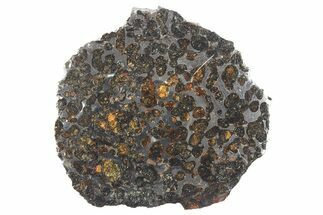This Specimen has been sold.
1.05" Polished Pallasite Meteorite (2.08 g) Slice - NWA 10023
This is a 1.05 wide (2.08 gram) slice of a Northwest African pallasite, NWA 10023. It has been cut relatively thin and fully stabilized to prevent rusting. Comes in an acrylic display case.
Don't miss out, as there is a very limited quantity of material from this meteorite.
Don't miss out, as there is a very limited quantity of material from this meteorite.
About Meteorite NWA 10023
NWA 10023 is a single, 6.95 kg pallasite meteorite reportedly recovered along the Morocco/Algerian border in 2014. When cut, it displays orange-brown-green, translucent olivine crystals and metal that makes up approximately 30 to 40% of the meteorite. The etched surface of this pallasite shows approximately 98% of the metal consisting of very fine-grained plessite, whereas kamacite occurs only as a thin mantling around olivine crystals. Olivine is the only silicate phase present. Accessory schreibersite, chromite, nickel-rich sulfide, and calcium-magnesium phosphates were observed.
Meteoritical Bulletin: Entry for Pallasite Meteorite NWA 10023
NWA 10023 is a single, 6.95 kg pallasite meteorite reportedly recovered along the Morocco/Algerian border in 2014. When cut, it displays orange-brown-green, translucent olivine crystals and metal that makes up approximately 30 to 40% of the meteorite. The etched surface of this pallasite shows approximately 98% of the metal consisting of very fine-grained plessite, whereas kamacite occurs only as a thin mantling around olivine crystals. Olivine is the only silicate phase present. Accessory schreibersite, chromite, nickel-rich sulfide, and calcium-magnesium phosphates were observed.
Meteoritical Bulletin: Entry for Pallasite Meteorite NWA 10023
About Pallasites
Pallasite meteorites are a class of stony-iron meteorites. They were once believed to have originated at the core-mantle boundary of asteroids that shattered through impacts, but a recent hypothesis is that they are a mixture of core and mantle minerals.
Pallasite meteorites consist of olivine (peridot) crystals surrounded by iron-nickel matrix. Upon acid etching, some pallasites display interweaving structures known as Widmanstätten patterns (or Thomson lines) in the metallic matrix. These structures are iron-nickel alloy crystals, typically kamacite and taenite, that cooled over millions of years in the vacuum of space.
Pallasites are quite rare: only about 200 are known, and only four have had observed falls. This represents less than 0.2% of all classified meteorites!
Pallasite Care
Pallasites are even more susceptible than most iron meteorites to rusting and deterioration due to moisture in the atmosphere; proper care includes keeping them in moisture-free environments. This is particularly important in areas with high humidity, such as Florida. All pallasite material we sell has been stabilized in some way, which will help with this issue, but care still needs to be taken to keep your treasure in good condition. Keep pallasites stored in a moisture-free environment, preferably with a corrosion inhibitor such as silica gel beads or a dehumidifier.
Pallasite meteorites are a class of stony-iron meteorites. They were once believed to have originated at the core-mantle boundary of asteroids that shattered through impacts, but a recent hypothesis is that they are a mixture of core and mantle minerals.
Pallasite meteorites consist of olivine (peridot) crystals surrounded by iron-nickel matrix. Upon acid etching, some pallasites display interweaving structures known as Widmanstätten patterns (or Thomson lines) in the metallic matrix. These structures are iron-nickel alloy crystals, typically kamacite and taenite, that cooled over millions of years in the vacuum of space.
Pallasites are quite rare: only about 200 are known, and only four have had observed falls. This represents less than 0.2% of all classified meteorites!
Pallasite Care
Pallasites are even more susceptible than most iron meteorites to rusting and deterioration due to moisture in the atmosphere; proper care includes keeping them in moisture-free environments. This is particularly important in areas with high humidity, such as Florida. All pallasite material we sell has been stabilized in some way, which will help with this issue, but care still needs to be taken to keep your treasure in good condition. Keep pallasites stored in a moisture-free environment, preferably with a corrosion inhibitor such as silica gel beads or a dehumidifier.
TYPE
Pallasite, PMG-an
AGE
LOCATION
Morocco/Algerian Border, Northwest Africa
SIZE
Size: 1.05 x .69 x .06", Weight: 2.08 grams
CATEGORY
ITEM
#301187
 Reviews
Reviews












